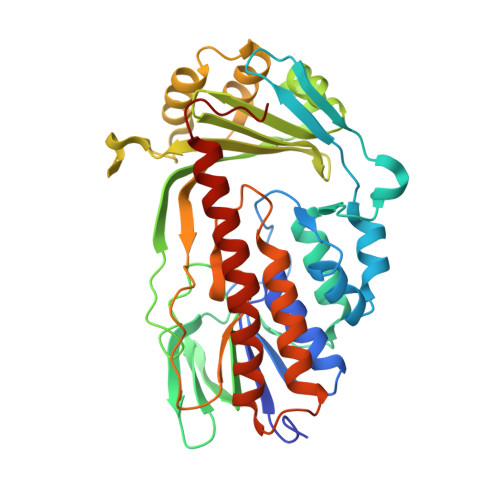Structural and mechanistic basis of the high catalytic activity of monooxygenase Tet(X4) on tigecycline.
Cheng, Q., Cheung, Y., Liu, C., Xiao, Q., Sun, B., Zhou, J., Chan, E.W.C., Zhang, R., Chen, S.(2021) BMC Biol 19: 262-262
- PubMed: 34895224
- DOI: https://doi.org/10.1186/s12915-021-01199-7
- Primary Citation of Related Structures:
7EPV, 7EPW - PubMed Abstract:
Tigecycline is a tetracycline derivative that constitutes one of the last-resort antibiotics used clinically to treat infections caused by both multiple drug-resistant (MDR) Gram-negative and Gram-positive bacteria. Resistance to this drug is often caused by chromosome-encoding mechanisms including over-expression of efflux pumps and ribosome protection. However, a number of variants of the flavin adenine dinucleotide (FAD)-dependent monooxygenase TetX, such as Tet(X4), emerged in recent years as conferring resistance to tigecycline in strains of Enterobacteriaceae, Acinetobacter sp., Pseudomonas sp., and Empedobacter sp. To date, mechanistic details underlying the improvement of catalytic activities of new TetX enzymes are not available. In this study, we found that Tet(X4) exhibited higher affinity and catalytic efficiency toward tigecycline when compared to Tet(X2), resulting in the expression of phenotypic tigecycline resistance in E. coli strains bearing the tet(X4) gene. Comparison between the structures of Tet(X4) and Tet(X4)-tigecycline complex and those of Tet(X2) showed that they shared an identical FAD-binding site and that the FAD and tigecycline adopted similar conformation in the catalytic pocket. Although the amino acid changes in Tet(X4) are not pivotal residues for FAD binding and substrate recognition, such substitutions caused the refolding of several alpha helixes and beta sheets in the secondary structure of the substrate-binding domain of Tet(X4), resulting in the formation of a larger number of loops in the structure. These changes in turn render the substrate-binding domain of Tet(X4) more flexible and efficient in capturing substrate molecules, thereby improving catalytic efficiency. Our works provide a better understanding of the molecular recognition of tigecycline by the TetX enzymes; these findings can help guide the rational design of the next-generation tetracycline antibiotics that can resist inactivation of the TetX variants.
- State Key Lab of Chemical Biology and Drug Discovery, Department of Applied Biology and Chemical Technology, The Hong Kong Polytechnic University, Hung Hom, Kowloon, Hong Kong.
Organizational Affiliation:


















